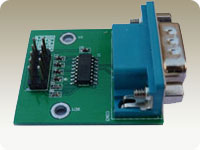RS232 Debug module is an DB9 RS232 to 3V3 TTL serial interface designed to get the access to the CoreWind boards debug port.

RS232 Debug Module is based on the popular MAX3232 chip. only change the TTL level to RS232 level, then you can connect it bwteen the board and the PC with the serial cable.
To use the RS232 Debug module you need a terminal emulator program that is an utility that can send and receive characters via a serial port.
Connect the Debug serial port on CORE9G25-CON board
Connect the Debug serial adapter to the J7(DEBUG) Port with 10Pin cable, then connect the DB9 to PC serial port.

Serial terminal emulator on Windows PC
By default Windows provide an utility called HyperTerminal that is usable with RS232 Debug module but we suggest to install a free utility called putty because it can works also as a SSH remote terminal useful to have access to the FOX command prompt via LAN (read this article).
It doesn't need to be installed, just download and run it, if you can't download it, you can find it in our CD.
At startup you have to specify:
- Connection type: Serial
- Serial line: COMx where x is the serial port allocated by the ftdi device driver
- Speed: 115200
Save this configuration and press the Open button to continue.

You will receive a request of login end password. Use these credentials:
Login: root Password: root
Serial terminal emulator on Linux PC
A simple terminal emulator available on Linux is minicom.
On Ubuntu distribution you can install it using Synaptic or apt-get install by typing:
~$ apt-get install minicom
After installation run it by typing:
~$ minicom
Type CTRL-A followed by O to show the configuration panel. Then select Serial port setup and access to the serial port configuration.
Se the port as shown below:
Welcome to minicom 2.4
OPTI+-----------------------------------------------------------------------+
Comp| A - Serial Device : /dev/ttyUSB0 |
Port| B - Lockfile Location : /var/lock |
| C - Callin Program : |
Pres| D - Callout Program : |
| E - Bps/Par/Bits : 115200 8N1 |
| F - Hardware Flow Control : No |
| G - Software Flow Control : No |
| |
| Change which setting? |
+-----------------------------------------------------------------------+
| Screen and keyboard |
| Save setup as dfl |
| Save setup as.. |
| Exit |
+--------------------------+
Type ESC the select Save setup as dfl. Then ESC again. Now pressing Enter you could have access to the board login.
Login: root Password: root
Schematic
Documentation Terms of Use
The Acme Systems srl provides this Debian system development and user manual.
The origin of these doc came from the website: http://www.acmesystems.it
This work is licensed under a Creative Commons Attribution-NonCommercial-ShareAlike 3.0 Unported License.


 微博
微博
